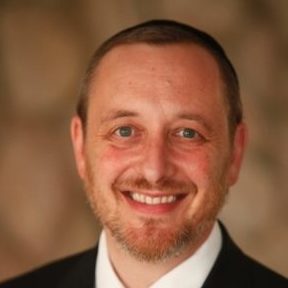Our Secret Weapon

Our world has returned to the generation of the Flood

Nebuchadnezzar and Titus were incapable of causing any damage to the Higher Worlds. Rather it was our sins that weakened, kiveyachol, the Higher Realms. We contaminated (and destroyed) the Higher Mikdash (in Heaven). All Nebuchadnezzar and Titus had to do was physically destroy the Lower Mikdash, corresponding to the Higher Mikdash. [But it was already destroyed by the hearts of man] as Chazal teach us (Eichah Rabbasi 1:43), kimcha techina techinas, (our enemies) ground flour that had already been ground…
[Nefesh Hachayim, 1:4]
THE INVISIBLE CHURBAN
Everyone loves visiting the enchanting city of Venice. It’s like walking into the inside of a real-life fairy tale, charming bridges over picturesque canals lined with jaw-dropping palazzos. Throw in hundreds of years of Jewish history and you can walk in the footsteps of the Levush, the Chidah, and the Ramchal.
Venice is also synonymous with its Carnival festival. Since 1162, Venetians would throw wild parties before Lent, a 40-day period in their religious calendar when they would abstain, among other things, from eating meat. Carnival is derived from carnis levare which literally means “remove meat.”
In the 14th century a new twist was added to the festivities. Venetians would parade in ornate masks and elaborate costumes that allowed them to hide their true identities. Class divisions instantly disappeared. Immoral behavior was rampant. Furthermore, the doge (Venetian duke) would allow mask wearers to write political charges or scandalous letters against anyone they chose and place the accusations in a box in front of the palace. The box still stands today.
The rabbanim of Venice were horrified. This was a catastrophe for the kehillah’s kedushah, especially their youth, who would mingle with the crowds and do lowly aveiros while hiding behind their masks. Cheremim (severe censures) were placed on anyone who participated.
Rav Moshe Dovid Valli (1697–1777), one of the greatest talmidim of the Ramchal, reflected on how degenerate Venetian yidden had become and writes:
Kol hamarbeh b’oso zman l’hishollel u’lhishtageiya yoser, hu yoser meshubach, [during the Carnival] whoever would act more foolishly and crazier than the next was considered [among his peers] more praiseworthy” [Likkutim 1:73].
He then adds something ominous. In describing the decadent world before the Mabul, the Torah writes, “Keitz kol basar ba lefanai — the end of all flesh (humanity) has come before Me.” (Bereishis 6:13) On the level of remez this can also be translated as, “The end of all meat has come to My attention,” referring to the decadence of the pre-Lent Carnival.
The immediate consequence is the Mabul, the Flood that destroyed the world.
Sound familiar? Imagine a realm where everyone is anonymous; a place without accountability. Imagine a space where one can defame and shame others at will, spread rumors instantly visible to billions worldwide. Imagine a vast network that could spread revolutions and spark deadly riots. Imagine having access to infinite choices to watch licentiousness and filth created by the dirtiest gutters of the human mind. With just a few finger movements.
Welcome to our world. The average American spends over seven hours a day hiding behind screens, and nearly 60 percent of adults admit to being addicted to their phones. Over 50 percent of children have seen inappropriate Internet content before their 12th birthday. Thirty-seven percent of teens have experienced cyberbullying. American consumers and businesses lost $12.5 billion in Internet crimes in 2023.
Society has paid the price: 23 percent of Americans have visited a mental health professional in the last year; double the number in 2004. Painfully, the statistics in our community are not significantly lower.
I remember when, over 20 years ago, my talmidim in Derech Ohr Somayach were explaining to me the concept of Wi-Fi. They described how every Jewish boy could hide in the privacy of their bedroom and have access to absolutely everything. I told them that Hashem would never allow such a thing to happen. How can mechanchim fight such an enemy?
Rav Moshe Shapira, the most self-controlled person I ever knew, once said that if someone would offer him a potion that would make him magically become young again, “hayiti zorek oto im bei’tot — I would kick him out.” Why? Because I would never want to be young in the age of the Internet.”
He described our world as a return to the Dor Hamabul, the Generation of the Flood.
A FLOODED WORLD
Obviously, we’re not in the Dor Hamabul in a literal sense; Hashem promised Noach that the Flood will never return (Noach 9:11). Conceptually, the Mabul was much more than a world covered with water that destroyed everything. It was a return to the second day of Creation, when the world was covered in water. (Zohar, 3:273; see Rabbeinu Bechaye, Bereishis 2:3)
On the third day of Creation, Hashem created dry land. Maharal (and others) frequently use two powerful words, chomer and tzurah, to describe fundamental ideas in Judaism. They are nuanced words and must always be understood in context. In understanding the difference between the second and third day, chomer implies raw material and potential; tzurah gives the chomer definition and makes it functional. A world covered with water has nothing, yet in potential it has everything. It just needs dry land to emerge from it and empower life.
Chomer can become tzurah with just the power of speech. As a mashal, imagine a slab and four sticks of wood. You can touch it and feel its texture and know that it feels cold under your fingers. You can smell it and discern the scent of pine. All you have is chomer. Now imagine you gave this chomer a name; you called it a table. At that moment all the wooden potential has been given tzurah; it’s now a defined and functional object.
We now have a new understanding of the Mabul. It was a natural consequence of a generation that had returned all tzurah of their civilization into chomer. Family structures and property ownership crumbled. This disintegration spread to the animal kingdom, where creatures would cohabit across species. The result was distorted progeny, lions that weren’t lions, tigers that weren’t tigers, and bears that weren’t bears (oh my!).
Rashi comments on the etymology of the word mabul, describing it as, “shebilah es hakol — it decayed everything; shebilbeil es hakol — it mixed up everything.” (Bereishis 6:17)
Fast forward to 2024, and all the tzurah of our world is decaying in front of our eyes. Once upon a time our society would flourish with well-defined structures. Kings were revered and loved by their people and nations had kings who were powerful and wise. Together the potential of the realm would be actualized. Male and female were defined genders who would build strong homes and communities. Parents were parents and children were children. Together the batons of family traditions and ideals were passed from generation to generation.
This has all but disappeared. America is the first country in history to be a global superpower that never had malchus. At least it has a presidency that is an echo of royalty. Alas, that, too, is vanishing. This has created a very dangerous world. In the words of Rav Dessler, “The fragility of our world resembles the short span of time between when an anti-Semite gets drunk and when he becomes violent.” And he said that 70 years ago.
What’s the primary matrix that has fueled the downfall of the tzurah of civilization? It’s the masked world of the Internet and its cohorts.
STAYING AFLOAT
Traditionally the Jewish home was a fortress. The walls would protect us from the outside world and allow us to nurture our loved ones from within. But like the bubonic plague, walls are useless against a wireless enemy. As a Brooklyn mechanech told me, “No matter how many filters you have, your child is as exposed as his weakest friend’s weakest friend.”
We’re forbidden to despair. Hashem told Noach that there’s a solution to the Flood. Enter the Teivah (Ark) and you’ll be safe. The Zohar describes the Teivah as an Aron Habris (1:59b). Interestingly, Teivas Noach and Aron Habris are both gematria 870.
Both the Teivah and the Aron are worlds that defy the laws of physics. The Teivah was just 300 amos long, 50 amos wide, and 30 amos high, yet contained two of every animal species. Some estimates say that there are over a million species of insects alone! The Teivah had no ventilation and was lit with a miraculous tzohar. It’s an environment that could sustain life for perhaps six or seven hours. Similarly, Chazal teach us that, “Aron eino min hamiddah,” it consumed no space (Megillah 10b). It stood 10 amos away from the walls of the Kodesh Hakodoshim, yet miraculously the Kodesh Hakodoshim was just 20 square amos.
The word teivah also means “word.” Rema M’Fano (Pelach Harimon 7:1) notes that the gematria of the three dimensions of the Teivah, (lamed 30 + shin 300 + nun 50) spell out the word “lashon,” tongue. The secret of the Teivah is that it was anchored in the power of the holy words of the Torah, represented by the Aron Habris, a world that is above and beyond the constraints of nature.
We mentioned that with words alone we can turn chomer into tzurah. On a metaphysical level, words of Torah can take the chomer of a physical world and elevate it to its noblest level of tzurah, a spiritual state that defies all laws of nature. In other words, just like our gedolim consistently remind us that only Torah protects our soldiers, and does so in miraculous ways, similarly Torah can protect our Jewish home and make it impregnable from a spiritually flooded world.
Simply spoken, our survival is found by making the Aron Habris the anchor of our lives. On a practical level, we must constantly ask ourselves what more we can do to attach our lives to Torah. The walls of our mikdash me’at must hear the sounds of Torah, reverberating in harmony with the joy and laughter of a relaxed and happy home. We need to say our morning birchos haTorah with added fervor, especially when we beseech Hashem that our children should enjoy the sweetness of Torah. We need to take our support of our local Torah institutions to a whole different level. In particular, the suffering of the yeshivos in Eretz Yisrael should be forever in our hearts and minds. We need to look for every opportunity to help them.
THE INVISIBLE NECHAMAH
The challenge of entering the Teivah is easier said than done. When we experience failure, we can easily slip into sadness, the plaything of the yetzer hara. Rav Wolbe would often quote the Arizal who said that a small achievement today is like a huge achievement in previous generations. Similarly, a huge aveirah today is like a small aveirah of yesteryear. When a young man struggling with the Internet holds himself back, just once, he should be very proud of himself. He has fulfilled the mitzvah of kedoshim tihiyu (see Ohr HaChaim Vayikra 19:2) and has unleashed untold goodness in the Higher Worlds. Reb Yeruchem’s classic essay Doros Ha’Achronim (Daas Torah 3:146) says that the insane challenges of our generation mean that simple Jews can be considered gedolim in Shamayim.
In less than two months we will storm the Gates of Rachamim reading the pesukim of Zichronos in our Rosh Hashanah Mussaf. In one of the pesukim we invoke the memory of Noach:
“…When You brought the waters of the Mabul to destroy all living flesh because of the evil of their deeds. Al kein, therefore, may his remembrance come before You….”
The Klausenburger Rebbe asks, the word “al kein,” implying a connection to the previous statement, seems irrelevant. What do the evil deeds of the generation have to do with Hashem remembering us for salvation and mercy?
He answers with a beautiful insight. Noach’s generation, the prototype of everything loathsome, was a particularly hard generation in which to be free of sin. Yet Hashem saved Noach and his family. Certainly, in our generation, where the tentacles of Carnival stretch across the globe and into every home, Hashem should treat us with kid gloves and forgive us.
The flood will not last forever. At the chosen moment Hashem will dry up the churban of tzurah and send us the Goel Tzedek. We will joyfully step out of our teivah and greet him. The Aron Habris will take its rightful place in the rebuilt Yerushalayim and the light of Torah will fill the world.
Rabbi Menachem Nissel is the Senior Educator of NCSY and teaches at Yeshivas Yishrei Lev and various seminaries in Yerushalayim. He is the author of Rigshei Lev: Women and Tefillah.
(Originally featured in Family First, Issue 905)
Oops! We could not locate your form.




